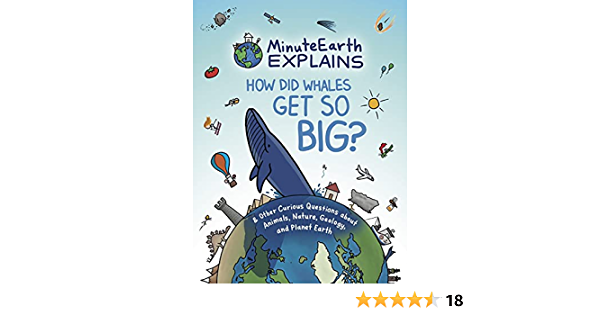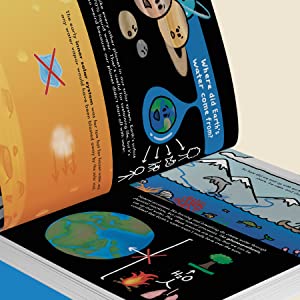“From cows” is what I said when my youngest son asked me. It was posed during his litany of questions as he’s driving down the gauntlet of Time For Bed Boulevard. He knows that if it’s the right night and he asks the right question he can suck me into his sleep avoidance. Alas, he was unsuccessful on that night, but his question got me thinking. I knew I had seen it asked in MinuteEarth Explains, How Did Whales Get So Big?, but in the heat of his bedtime minute, I couldn’t come up with a more precise answer. The specific answer to his question will completely surprise you, as well as admire the ways it’s marketed.

What fifth through tenth graders will initially notice about How Did Whales Get So Big? is how approachable the book presents its content. It’s loaded with illustrations that evoke a slightly retro vibe. They’re engaging, funny, entertaining, and educational. A silly illustration can teach kids things that pages of age-appropriate facts will never accomplish.
Look at the dead stick figure with diarrhea as it sits above a body of water. As the watery goo is making its way through the stick figure’s deceased body we see a close-up diagram of a very muscular Cholera action figure. Cholera has a machine that’s supercharging copies of itself, complete with a jet pack. The people in the water are getting sick, someone is drinking water from the same source and it all trickles downhill. For some reason, I chose the most disgusting graphic in the book for this example. Every illustration in the book, EXCEPT for this one is STEM-based, and not at all related to potty movements. However, I’m a stream of consciousness writer, so let’s move on, shall we?
Even without reading the text, people will be able to infer exactly why some diseases are so deadly. Those four pages let readers know the seriousness of some diseases, while at the same time, presenting the content in a manner that won’t intimidate young readers. When you add the conversational text that’s telling readers about a myriad of common questions, with answers that will surprise you, the result is conversation magic.
It’s in that conversation where kids can learn things that will stick with them or encourage further education. Had I taken the bait when our child asked about cows then perhaps we could fast forward 25 years and he might’ve become the world’s leading bovine expert. How Did Whales Get So Big? is an excellent example of soft learning. It’s what some National Geographic Kids books do so well. In presenting small, bite-sized chunks in an entertaining and curious manner it encourages kids to learn by removing perceived barriers.
The text is too wordy. The illustrations are too realistic. It feels like a school book. It’s not fun to read. It’s boring. It’s a baby book. The book is too old for me. Think of an obstacle that any person aged eight and up could present as a defense mechanism or excuse in not wanting to read (ie: learn from) the book and it’s immediately disqualified.
Moreover, the book is different and feels fresh. Some upper elementary and middle school readers ‘age out’ of STEM books like these simply due to presentation. Most likely, they are used to seeing non-fiction fact content like this in a National Geographic book. Their presentation is photograph-driven and concentrates on informational blurbs or paragraphs.
How Did Whales Get So Big? has big enough vocabulary to challenge older readers. The illustrations draw in the younger readers, and the facts stand on their own, as well as building to a bigger conversation. The book poses 24 questions and then spends four pages on each question. It spends those pages illustrating different things that impact the query, explaining why they happen in text and overtly asking questions along the way. Some questions lead people to the next question. There’s a particular food line of questions, much in the way that filtered cow blood is the raw, and much less palatable answer to the question that started us all of with, How is Milk Really Made?
MinuteEarth Explains, How Did Whales Get So Big? is written and illustrated by MinuteEarth, it’s published by DragonFruit, an imprint of Mango Publishing.
There are affiliate links in this post.






 Facebook
Facebook Twitter
Twitter Flickr
Flickr GooglePlus
GooglePlus Youtube
Youtube